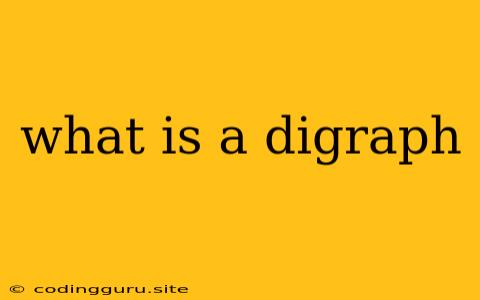What is a Digraph?
In the world of computer science and linguistics, the term "digraph" holds a special meaning. While it might sound like a complex concept, it's actually quite simple to understand.
A digraph, in essence, is a pair of consecutive letters that represent a single sound. It's like a duo act in the world of phonetics, where two letters work together to create a unique sound.
Let's break down the concept further with examples:
Digraphs in English:
- "sh": This digraph is commonly found in words like "ship", "fish", and "crash". It represents a single sound, often described as a hissing sound.
- "ch": Words like "chair", "church", and "catch" showcase the digraph "ch", which produces a distinct, often harsh sound.
- "th": This digraph appears in words like "think", "that", and "them". It can represent two different sounds: the voiceless "th" sound (as in "thin") and the voiced "th" sound (as in "this").
- "ph": Words like "phone", "graph", and "phantom" use the digraph "ph" to represent the "f" sound.
- "wh": This digraph is found in words like "what", "where", and "when". It often represents the sound of "w", but can also represent the "h" sound in some words.
Digraphs in Other Languages:
Digraphs are not exclusive to the English language. They can be found in various languages, including:
- "sch" in German: This digraph is often pronounced like the English "sh" sound, as in "Schule" (school).
- "au" in French: This digraph represents the "o" sound in words like "au revoir" (goodbye).
- "ai" in Japanese: This digraph represents the "ai" sound in words like "aiai" (love).
Common Misconceptions:
It's important to note that not all combinations of two letters are digraphs. For instance, the letters "st" in the word "stone" do not represent a single sound. Each letter individually makes its own sound.
Why are Digraphs Important?
Digraphs play a crucial role in both written and spoken language:
- Spelling Consistency: Digraphs help maintain consistency in spelling, even though a single sound might be represented by different letter combinations.
- Pronunciation Accuracy: Understanding digraphs is vital for accurate pronunciation, as they help us decipher the intended sound of a word.
- Language Learning: For language learners, recognizing digraphs helps them grasp the complexities of pronunciation and spelling in a new language.
Digraphs in Programming:
Digraphs also have their own unique significance in the world of programming. They are often used to represent special characters or control codes in programming languages like C and C++.
For instance, the digraph "##" might be used to represent the "#" character, while "//" might be used to represent the "backslash" character.
Conclusion
In conclusion, a digraph is a simple yet powerful tool in the world of language and programming. Understanding its various uses and functions enhances our ability to read, write, and speak clearly. It also helps us navigate the complex world of coding languages. By recognizing the unique combinations of letters that form digraphs, we gain a deeper understanding of the intricacies of language and its various forms.
